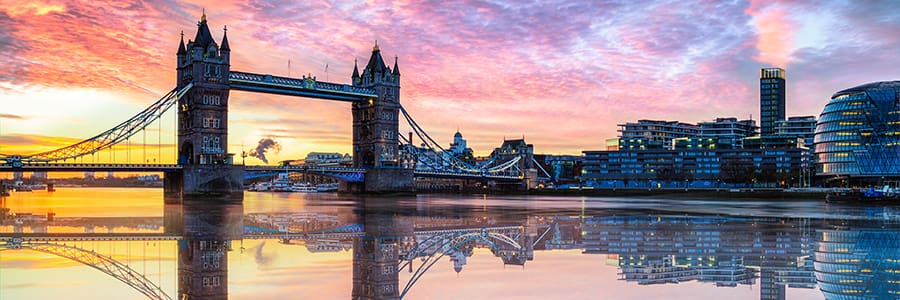
About The River Thames
The Thames may take its name from the Sanskrit Tamas, meaning “dark,” as its waters are often dark and cloudy.
The Thames is the longest river in England and the second longest in the United Kingdom. Its source is located in the Cotswolds and it flows for approximately 215 miles across the south of England before emptying into the North Sea at the Thames Estuary. Thames river cruises provide an excellent opportunity to experience the tranquil rural beauty of England’s southern counties.
Cruising in comfort and style through the picturesque landscapes like Oxfordshire and Berkshire, a region that inspired Kenneth Grahame’s The Wind in the Willows, you’ll visit quintessentially English towns while enjoying delicious meals and classic British hospitality.
Cruises along the Thames can vary from one cruise to another, depending on length of cruise, location, and focus of the sightseeing. They are typically on small canal barge cruisers that can ply the waters of the Thames west of London. London, of course, is a destination in itself, and there’s no better way to see it all that from your very own floating hotel.
River Thames Stats
Length: 215 miles
Depth: Maximum depth of 66 feet
Source: Gloucestershire, England
Mouth: Thames Estuary into the North Sea, England
Locks: 45
Countries: England
Learn More About the River Thames of England
The River Thames, often simply referred to as the Thames, is one of the most iconic and historically significant waterways in the world. Flowing through southern England for approximately 215 miles (346 kilometers), it has been a central character in the story of Britain for thousands of years. From its source in the Cotswolds to its estuary in the North Sea, the Thames has shaped the geography, culture, and history of the region it traverses.
Geography and Source
The journey of the Thames begins in the Cotswold Hills, specifically at Thames Head, near the village of Kemble in Gloucestershire. This humble source is a far cry from the mighty river it will become, but it marks the beginning of an extraordinary journey. As it meanders through the picturesque countryside, the Thames collects water from numerous tributaries, gradually gaining strength and momentum.
London and the Estuary
The Thames reaches its most famous stretch as it flows through London. The city owes much of its historical significance and development to this river. London’s history is tightly intertwined with the Thames, and it has served as a lifeline for trade, transportation, and sustenance for centuries. The city’s iconic landmarks, such as the Tower Bridge, the London Eye, and the Houses of Parliament, all owe their prominence in part to their proximity to the river. The Thames has witnessed countless historical events, from the Roman settlement of Londinium to the Great Fire of London and the Blitz during World War II. As the river approaches the North Sea, it widens into the Thames Estuary, a complex and ecologically vital network of tidal inlets, salt marshes, and sandbanks. The estuary is home to a diverse range of wildlife, including seals, wading birds, and fish, making it an essential area for conservation efforts.
Historical Significance
The Thames has long played a pivotal role in British history. It was a key trade route during the Roman period, facilitating the movement of goods and people. In the Middle Ages, it served as a bustling center of commerce, and the city of London flourished along its banks. The river’s significance in national history is evident through landmarks like the Royal Palaces of Hampton Court and the Palace of Westminster, both situated along its shores. Monarchs have traveled by barge along the Thames for centuries, and royal ceremonies continue to take place on its waters. During the Victorian era, the Thames underwent significant engineering projects, including the construction of the Thames Embankment to combat flooding and the modernization of London’s sewage system. These initiatives transformed the river into the navigable, cleaner waterway we see today.
Culture and Literature
The Thames has not only been a muse for painters and poets but also a central character in literature. From Charles Dickens’ “Oliver Twist,” which opens with a scene along the Thames, to Jerome K. Jerome’s humorous “Three Men in a Boat,” countless novels have been inspired by the river’s beauty and character. Moreover, the river has been a subject of paintings by renowned artists like J.M.W. Turner and Claude Monet, who captured its ever-changing moods and atmospheric qualities.
Leisure and Recreation
Today, the Thames is a playground for leisure and recreation. People stroll along the South Bank, dine in riverside restaurants, and enjoy river cruises that offer stunning views of London’s skyline. Rowing, sailing, and kayaking are popular activities on the river, and annual events like the Oxford and Cambridge Boat Race draw crowds from around the world.
Environmental Concerns
Despite its enduring charm, the Thames has faced environmental challenges. Pollution, particularly in the 19th and early 20th centuries, led to the river being known as “The Great Stink.” Efforts to combat pollution, improve water quality, and restore habitats have made significant strides, but ongoing vigilance is essential to protect this vital ecosystem.
